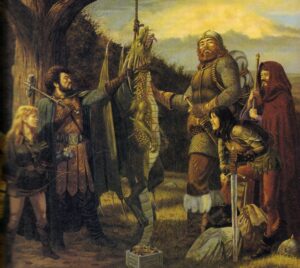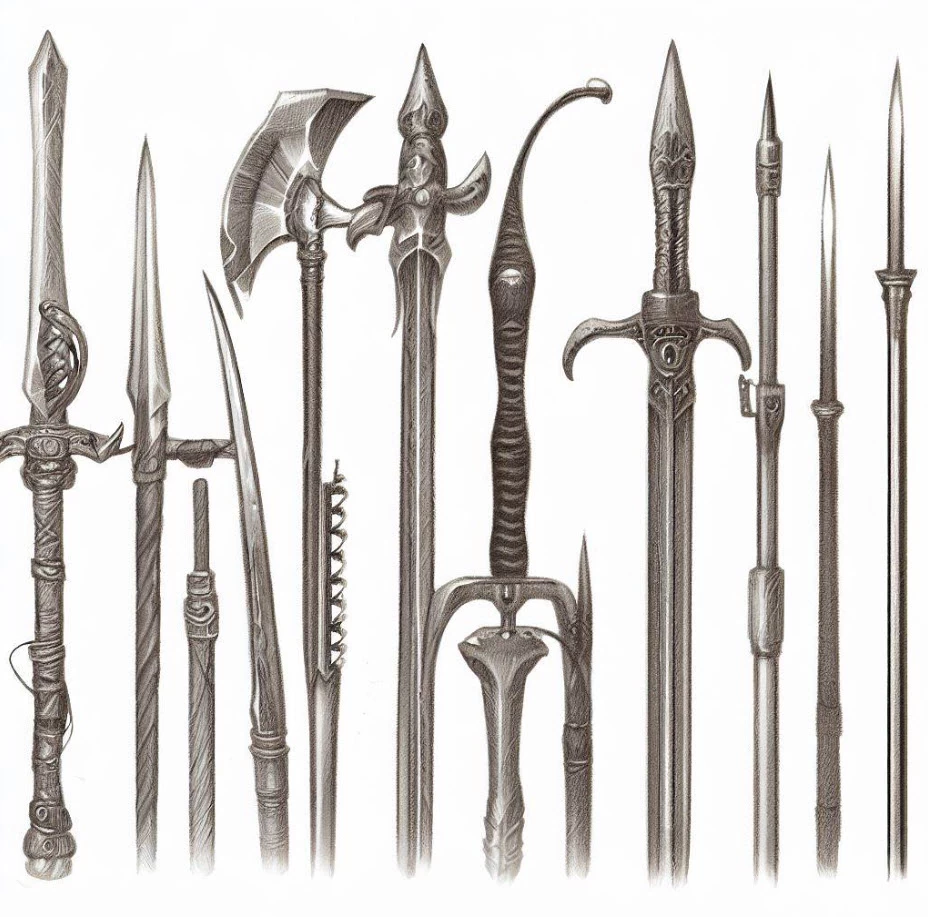
In the vivid tapestry of the medieval period, a plethora of weapons etched their marks onto the battlefields, defining an era of knights, castles, and legendary conflicts. Yet, as one delves into the intricacies of medieval weaponry, a perplexing issue surfaces - the ambiguous nomenclature and classifications that muddle the historical landscape. The diversity in the terminology adopted by various authors, some considered authorities in the field, has inadvertently woven a complex web of confusion that befuddles historians and enthusiasts alike.
This confusion is not merely a pedantic concern but a significant hurdle in the clear and accurate study of medieval warfare. Through an investigative lens, let us unravel the convoluted world of medieval weaponry, offering clarity and insight to the serious student of this fascinating epoch.
Complexities Weapon Misclassification
In literature that navigates the world of ancient armaments, a startling number of misclassifications and errors in terminology are glaringly apparent. Even respected works, such as "Warriors and Weapons of Early Times" by Niels M. Saxtorph, sometimes fall prey to this issue, misidentifying weapons with distinct characteristics, thereby leading readers into a mire of confusion and misinformation. This segment explores examples of such misnaming and sheds light on the critical differences between weapons that are often wrongly interchanged.
Complex Genesis and Evolution of Medieval Weapons
Before immersing ourselves into the complex classification system, it is essential to understand the roots of medieval weaponry. Primarily stemming from adaptations of hunting equipment or agricultural tools, these weapons underwent a significant evolution, morphing into highly specialized forms or amalgamations attempting to harness multiple strengths. This section delves into this fascinating progression, providing a firm foundation for understanding the nuances that differentiate various armaments.
Polearms: The Infantry Weaponry
Pole arms, in their essence, marry simplicity and functionality, offering a profound advantage on the battlefield. From formidable pikes to axe blades, the range of weapons encompassed by this term is indeed expansive. In this section, we shall define and explore the pole arm's rich variety, detailing their characteristics and showcasing how their development revolutionized warfare strategies.
Weapon Classification
To navigate the labyrinthine world of medieval weaponry successfully, a well-defined system of classification is crucial. This section presents a meticulously researched framework that seeks to bring coherence and precision to the study of these ancient armaments. By adopting a logical and organized approach, we aim to facilitate a deeper appreciation and understanding of the vast array of weapons that flourished during the Middle Ages.
The study of medieval weaponry is a journey fraught with complexities and nuances. Through this exploration, we have endeavored to demystify the tangled web of nomenclature and classification that often stymies serious scholars in the field. As we stand on the cusp of a clearer understanding, it is hoped that this structured approach will pave the way for more insightful and accurate investigations into the riveting world of medieval armaments, fostering a renewed appreciation for the ingenious designs and strategies that marked this era of warfare.
Lance
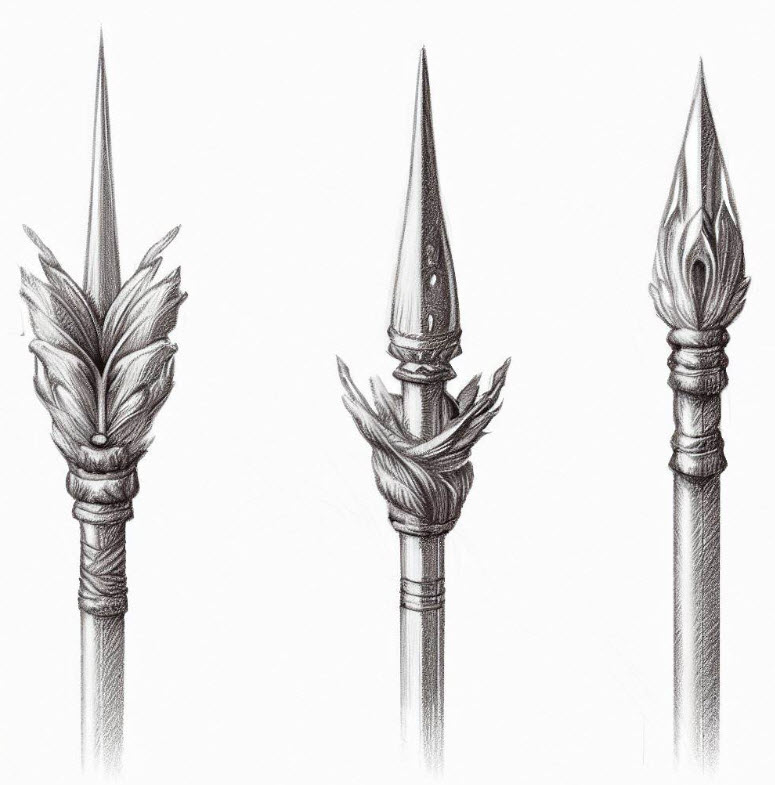
A lance, fundamentally a lengthened spear, serves as the quintessential weapon of a mounted warrior. In the Norman era, these formidable instruments measured approximately 12 feet, though as the Middle Ages progressed, they evolved to an impressive average span of 14 feet. This adaptation granted the rider an extended reach of about 10 feet beyond their steed's head during fervent charges, offering a strategic advantage on the battlefield.
Much like its counterparts, the spear and pike, the lance embraced a variety of head designs, each tailored to counteract the diverse forms of opponent armor encountered. A notable utilization of lances can be traced back to Austrian knights and men-at-arms during the Battle of Sempach in 1386. In a tactical shift, the Austrians relinquished their mounts to engage a Swiss force that lacked the customary high concentration of pikes, common in later Swiss formations. This maneuver showcased the lance's versatility and effectiveness in hand-to-hand combat.
Fauchard
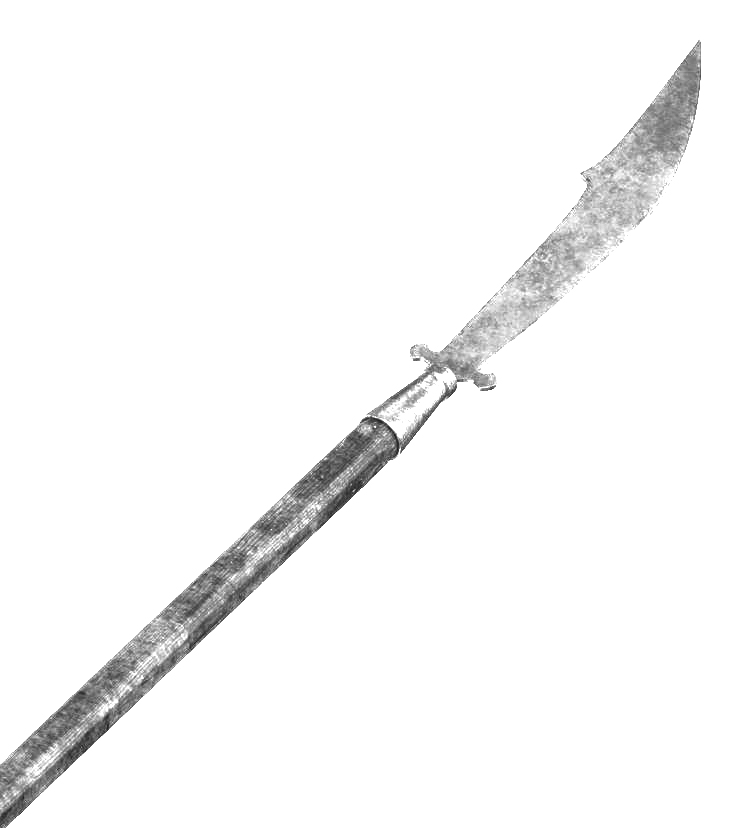
This instrument emerged from the evolution of the scythe or sickle. Mounted on a long shaft, the arched blade of a fauchard was designed for both slashing and thrusting actions, although its efficacy in both capacities is quite doubtful. Additionally, the early and more prevalent versions of this weapon lacked features for effective blocking or grappling and did not facilitate the unseating of mounted combatants. While later iterations incorporated a rear hook intended for dismounting riders, the fauchard still lacked efficiency and consequently fell out of favor rapidly, albeit its hybrid variant, the fauchard-fork, persisted.
Spear

The spear, characterized by a sharp blade mounted on a long shaft, stands as one of the most ancient and versatile pole arms known to mankind. Though it often escapes mention in general classifications, it holds a significant place in the arsenal of historical weaponry. Primarily designed for piercing attacks, its functionality extends further when equipped with a broad blade, resembling that of an "ox tongue". This modification not only enhances its reach but grants it a dual role, allowing for slicing maneuvers in the heat of battle.
Notably, in English literature, spears extending around 12 feet are commonly denoted as "ash spears". However, their substantial length frequently causes them to be mistaken for pikes, another prominent member of the pole arm family, thereby adding a layer of complexity to their identification and classification in historical studies.
Pike
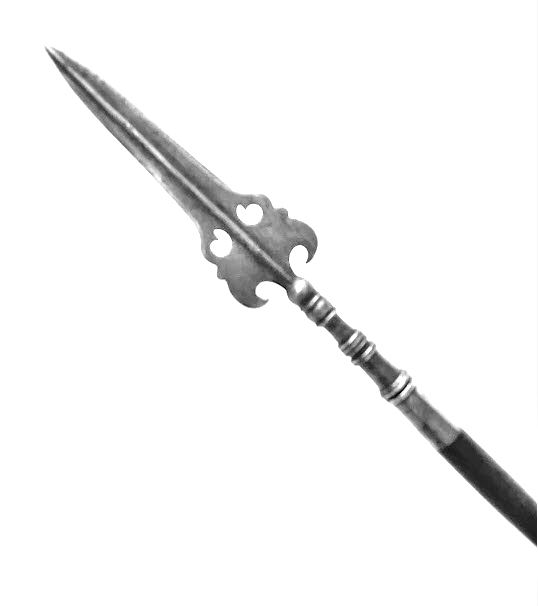
While there isn't a universal standard, a spear boasting a shaft that extends 15 feet or more generally falls under the category of a pike. Crafted to facilitate long-range thrusting assaults, the pike's substantial length served a dual purpose - not only to attack from a distance but also to maintain that distance, especially since this weapon was typically utilized in large formations.
A prominent variation of the pike is the awl pike, primarily designed for piercing actions, although numerous other blade designs have also been employed to enhance its efficacy. Notably, the Swiss and German pikes were constructed with an additional metal reinforcement covering up to two feet of the wooden shaft from the head, thwarting attempts to sever the blade and render the weapon ineffective.
Transitioning to the intricate realm of specialized and combination pole arms, it is essential to clarify a prevalent misconception - not all pole arms outfitted with a spearhead, or "dagger", can be classified as spears or their derivatives. Unfortunately, this is a common error encountered in literature on pole arms, wherein authors mistakenly categorize these weapons based on their secondary functionalities, losing sight of their primary purpose. It is imperative to recognize that the core function of a spear is thrusting, meaning that the diverse range of specialized and combination pole arms within the spear lineage should predominantly operate as thrusting instruments.
Spetum
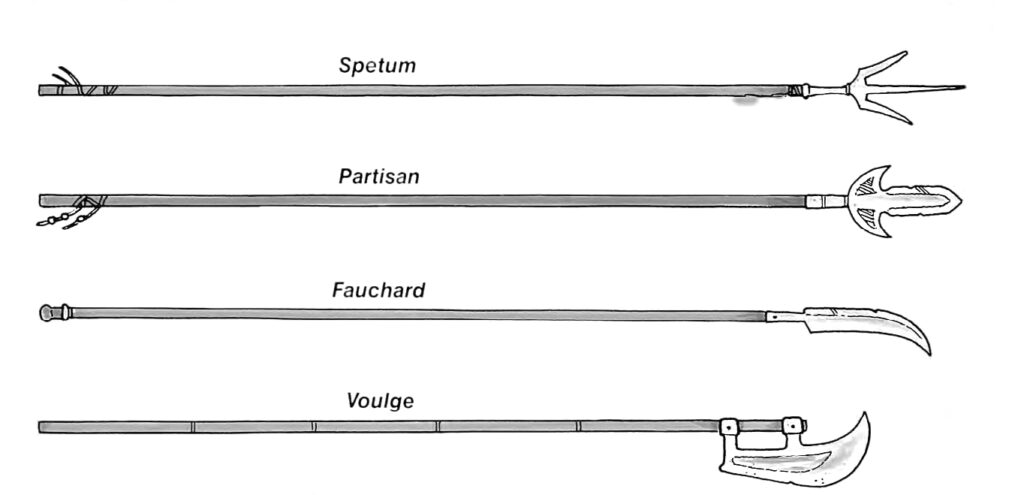
The spetum, a weapon engineered to enhance the traditional spear's offensive and defensive prowess, stands as a formidable asset in medieval warfare. It incorporates a unique design where, alongside a central sharp tapering point, two forward-facing blades are affixed at approximately a 45-degree angle. These additional blades not only amplify the attack capabilities but also serve as a defensive mechanism to deflect opposing weapons. Moreover, they can ensnare and restrain adversaries from a safe distance if the initial blade assault doesn't achieve penetration. Parallel to the spetum in function and category are the diverse variations of corseques or korsekes, which share similar multifaceted capabilities on the battlefield.
Ranseur
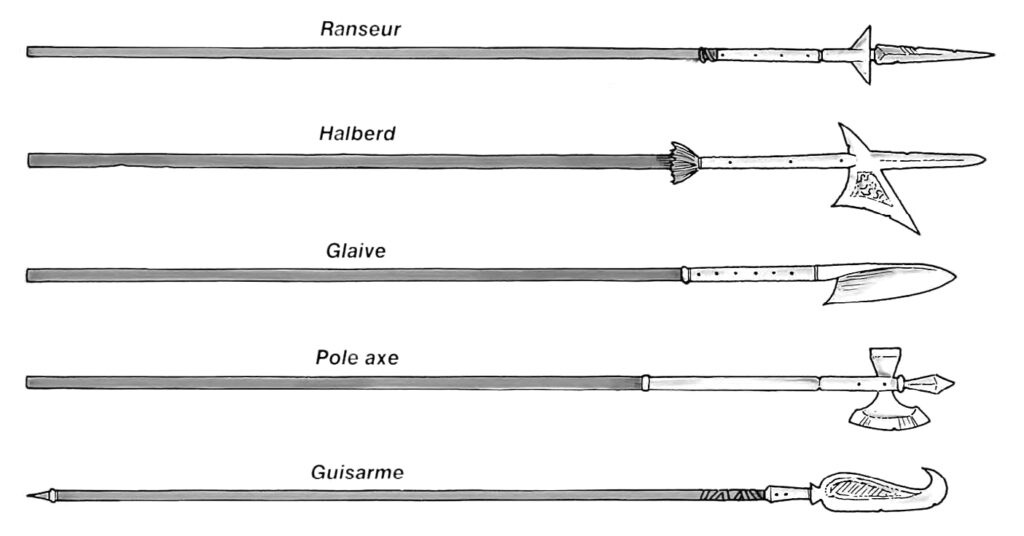
Upon initial observation, one might mistakenly equate the ranseur with the spetum, or perhaps the other way around. However, a closer examination reveals that the ranseur boasts a more intricate design compared to its counterpart. The distinguishing features of the ranseur lie in its secondary blades, which are backward-hooking structures strategically situated significantly below the large central blade.
While the ranseur undeniably retains a spear's piercing functionality, its defensive capabilities extend further. It is designed to capture enemy weapons in the gap beneath the primary blade, where a skillful twist of the shaft can utilize the pressure exerted by the central or secondary projections to either snap the entrapped weapon or disarm the opponent effectively. These side projections serve a dual role, facilitating either the retention of adversaries at a considerable distance or unseating mounted foes from their horses, thereby providing a tactical advantage on the battlefield.
In the context of historical weaponry, the ranseur shares its category with other analogous weapons, often referred to by various names such as chauve-souris, ransom, rhonca, roncie, and runka, each showcasing slight variations in design yet following a similar functional philosophy.
Partisan

This variant of pole arm fundamentally originates from a spear, often furnished with an ox tongue blade, enhanced with a couple of diminutive axe heads positioned below the dagger blade. This integration augments the spear's initial thrusting capacity with the defensive attributes and the slicing or penetrating prowess of the side axe blades. As time progressed, the partisan underwent transformations, particularly in the axe blades, rendering them nearly indistinguishable from their original form.
A classic example of this evolution is seen in the Bohemian earspoon, a partisan derivative where the axe components have been modified into piercing spikes, primarily designed to penetrate plate armor, aligning closely with the functionalities of a ranseur. This evolutionary complexity has given rise to a common mix-up between spetums, ranseurs, and partisans, a confusion further amplified in later versions of partisans that feature adaptations like spetum-inspired projections and ranseur-esque gaps, facilitating the trapping of enemy weapons.
Therefore, the diverse spear lineage encompasses the standard spear, the elongated version known as the pike, alongside the spetum, ranseur, and partisan. Essentially, all entities within this category represent an enhanced version of a dagger mounted on a robust pole, each refinement aimed at optimizing the weapon's efficacy in various aspects.
The Pole Axe

The axe manifested in numerous variations and merged with many fundamental weapon types to constitute a vast and diverse family. However, it is worth noting that not all pole arms labeled as axes genuinely fit into this category. Essentially, axe heads can be categorized into two primary forms: broad and narrow. The latter variation is generally thicker, compensating for its narrowness by adding necessary weight.
A variant of the axe, the cleaver, originally a tool for butchery, found its way onto the battlefield as a formidable weapon. Several pole arms within the axe and cleaver categories were outfitted with spear points, offering a secondary means of thrusting. Despite this addition, the primary function of these weapons remained hacking at the enemy rather than impaling them.
In the purest sense, a pole axe is simply an axe head, regardless of its type, affixed to a long shaft, facilitating more immediate and potent strikes. This weapon may feature a double-edged blade, be reinforced with a spike, or even crowned with a spear-like point, yet its identity as an axe remains unmistakable.
The Pole Cleaver (meat cleaver)
It is highly plausible that an infuriated farmer attached his meat cleaver to the end of a long stick to safeguard himself and his family, consequently giving birth to a style of weapon that would see extensive use across Europe and the British Isles for numerous centuries. This origin story is consistent with a large portion of the other pole arms that are to be explored; primarily, they were humble agricultural implements repurposed for militant applications, retaining recognizable and distinguishable forms until their gradual evolution into more composite and sophisticated structures made their categorization slightly challenging.
Nevertheless, this latter phase of development is not overly complex to navigate, especially for readers who have a deep understanding of the fundamental shapes of each rudimentary agricultural tool turned weapon.
Halberd

This variant of the pole axe typically features a convex-headed broad axe in its earlier iterations, uniquely positioned at an angle that anticipates the most probable point of contact with an enemy, setting it apart from the standard long-hafted axe. Often measuring up to 8 feet, this weapon is invariably equipped with a considerable spear point at its tip and complemented by a rearward spike, which might bear a slight downward curve or hook.
The spear point is primarily designed for thwarting advances and executing thrusting attacks, although it demonstrated limited efficacy against mounted knights wielding lances, as evidenced in the Battle of Arbedo in 1422. Meanwhile, the rearward spike serves a dual purpose: piercing heavy plate armor and functioning as a hook to unseat opponents from their mounts.
Prominently utilized by the Swiss and Germans, the halberd underwent substantial alterations and advancements over a span of two centuries. It was not uncommon to encounter variants with concave blades, some remarkably pronounced, aiming to enhance armor penetration capabilities. Some halberd heads were even diminished in size, like the piercing axe, to better breach armors. It should be noted that several depictions of these weapons in historical texts are not indicative of battle-ready arms, but rather illustrate elaborate parade weapons.
The categorization of some weapons has also been a point of confusion; bills and voulges have sometimes been referred to as halberds, though a careful observer will recognize distinct differences in their form, particularly considering their intended applications.
Bardiche
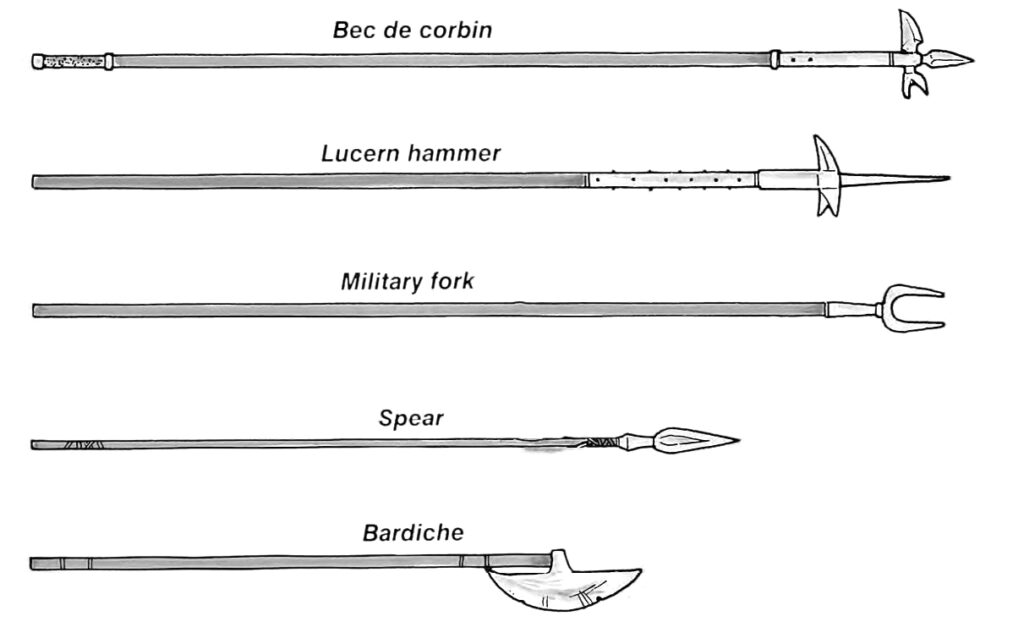
This robust and weighty axe serves as a connecting link between pole axes and pole cleavers, functioning as an intermediary stage in the evolution from one to the other, even though its primary role appears to be in military engagements. The length of a bardiche head typically varies between 2 to over 3 feet, and it is affixed to the shaft via a pair of rings or occasionally, a single ring, particularly in cases where the blade is more compact and complemented with a hammer head or spike at the back. Notoriously heavy and unwieldy, the bardiche far surpasses the halberd in terms of its cumbersome nature, finding its primary use in the regions of Eastern Europe.
Indeed, the category of axes mounted on poles for wartime application extends and intersects with numerous other weapon classifications. However, the authentic members of this category are restricted to the pole axe, the halberd (potentially including the brown bill), and the bardiche. That said, the corresponding cleaver-esque weapons bear such a resemblance in terms of functionality that they might practically be regarded as a subtype of pole axes.
Voulge
Mount a substantial cleaver at the terminus of a long, robust handle, and the pole grants the user the leverage needed to slice through armor. In its rudimentary version, the voulge doesn't offer features to maintain adversaries at bay, but by modifying the upper front or rear edge to create a pointed or dagger-like end, the weapon evolves into a more versatile entity. Occasionally, the voulge was complemented with a straight or hooked spike, transforming it into a rudimentary guisarme-voulge, a hybrid weapon type.
Glaive
Behold the glaive, a majestic harbinger of doom, marrying the vicious elegance of a single-edged knife with the formidable reach of a stalwart staff. An embodiment of raw power and agility, the glaive echoed the primal savagery of the spear, coupled with the brutal cutting prowess befitting the finest blades of the age. As legends grew and battles raged, so did the glaive evolve, its blade burgeoning in size and menace, promising not just enhanced cleaving assaults but a spectacle of destruction that beheld foes with both awe and fear.
Yet, in its primal form, the glaive faced the crucible of the battlefield, its inability to restrain adversaries or facilitate piercing and dismounting assaults marked as its Achilles' heel. But the flames of innovation roared once more, giving birth to the glaive-guisarme, a magnificent reincarnation discussed amidst the revered annals of combination-arms lore. This evolution witnessed a convergence, where the boundaries blurred between the cleaver-esque might and the glaive, forging a weapon so awe-inspiring that it threatened to redefine the very art of warfare.
Thus, in the theatre of battle where glory and doom danced in a relentless embrace, the glaive stood tall, a testament to mankind's ceaseless pursuit of mastery and might, a symbol of an era where the whispers of steel sang the epic tales of legends forged and fallen.
Lucern Hammer
In the fierce arsenal of history, the Lucern hammer stood distinct: a behemoth with a long, defiant spike and a tri-pronged hammer head, a fierce predecessor to the mighty halberd, commanding both awe and respect in the theater of battle.
Bec de Corbin
Upon closer inspection, the distinction between the bee de corbin and the Lucern hammer unveils itself, manifesting in the grandeur of its craft and the subtleties of its design. Adorned with a crow's-beak blade, it was the weapon of choice among the nobility during the twilight of the Middle Ages and the dawn of the Renaissance. Crafted to pierce through the sturdy plate armor of high-born warriors, its beak stood as its crowning glory, backed either by a flat, formidable hammer head or a clawed counterpart resembling that of the Lucern hammer. Yet, its end spike trades length for a blade-like precision, distinguishing itself from the Lucern hammer's awl spike in specialization and finesse.
Guisarme
In a time of dire need, medieval peasants transformed their humble pruning hooks into formidable guisarmes, instruments of resilience against oppression. Born from necessity, these primal pole arms bore the weight of revolution, evolving swiftly into the paragon of weaponry. Sharp and unforgiving, they promised the fury of a swing, the bite of a hook, and the piercing cold of a spike. These were the forefathers of a new era of combat, laying the foundation for a lineage of versatile and deadly pole arms, ready to bring knights to their knees and change the course of battles forever.
Bill Hook
The English billhook stood as a formidable counterpart to the French guisarme, bearing a distinct and sharp concave edge that threatened to rend armor with ease. Further distinguishing itself with a forward-jutting L-shaped tine instead of a straight back spike, it held a slight yet crucial advantage in the battlefield, promising a greater efficacy in the heat of European conflict.
Military Fork
Transformed from humble beginnings, the agrarian hay fork evolved into the formidable military fork, a weapon boasting dual piercing points adept at fending off adversaries. Sometimes featuring a shorter third tine nestled in its fork's crotch, it funnelled enemies into a trifecta of potential attacks. Despite its prowess, it grappled with a significant limitation - a diminished potency against heavily armored foes. This shortfall, however, paved the way for innovation, marrying the fork principle with other pole arm designs to birth a new generation of highly efficient instruments of war.
May want to consider reading Chilled to the Bone: The Perils of Cold Adventuring in D&D



